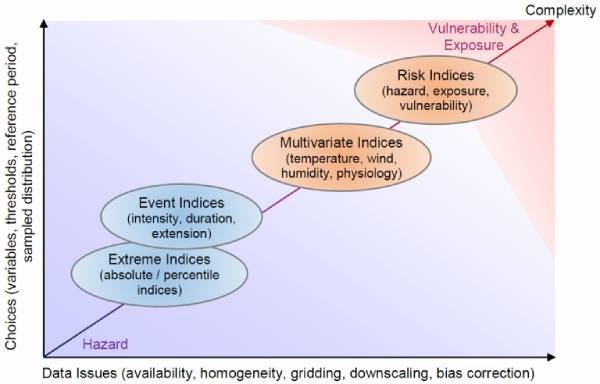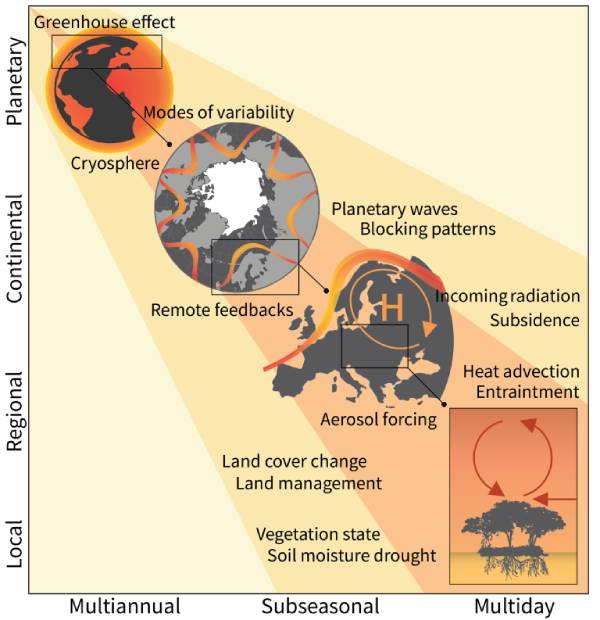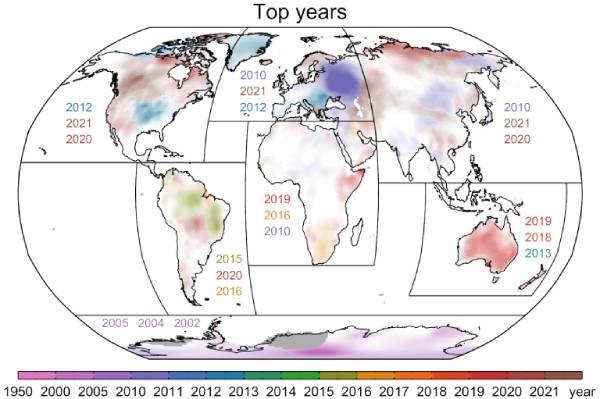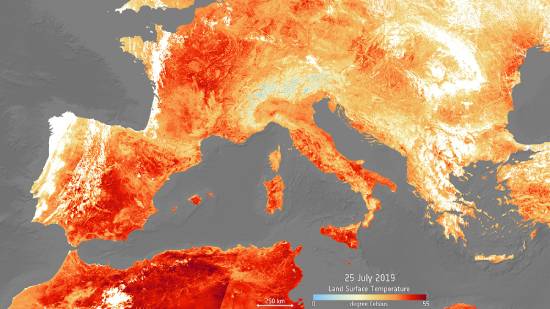Heat waves are extreme climate events that have become a major societal concern since they are expected to increase in frequency, intensity, and duration throughout the 21st century.
A recent study in Reviews of Geophysics explores the current understanding of heat waves and the main scientific challenges. Here, we asked the authors to give an overview of heat waves, their relationship with other hazards and climate, and what questions remain.
In simple terms, what are heat waves and what kinds of criteria are used to define them?
Heat waves are periods with temperatures significantly higher than the usual values recorded in a given place. This can happen at any time of the year, but in regions with marked seasonality, the term is usually applied to those occurring in summer. There is no universal definition of heat wave (see Figure 1), but a minimum intensity (temperatures above a certain threshold) and duration (usually three consecutive days or more) are common criteria. Depending on the purpose, additional conditions or variables can be considered to assess their characteristics (e.g., areal extent) or associated impacts (e.g., heat stress).

Figure 1: Schematics of different types of heat wave definitions (temperature-based indices in blue, and composed impact-oriented indices in orange), distributed according to the level of complexity (diagonal) as inferred from data issues and choices involved in the definition. Credit: Barriopedro et al. [2023], Figure 1
What are the main drivers of heat waves?
Heat waves result from interactions among drivers of different nature acting at different spatio-temporal scales (Figure 2). In recent years, global warming has been a key driver, making heat waves more frequent and intense in most areas of the world. Natural climate variations, like El Niño–Southern Oscillation (ENSO), also affect heat waves on interannual to multidecadal scales. Atmospheric planetary waves and high-pressure weather systems are common immediate drivers in extratropics. Other proximate factors, such as vegetation and the moisture content of the soil can instigate and exacerbate heat waves through complex feedbacks with the atmosphere. The drivers and their relative importance can vary regionally and from event to event.

Figure 2. Characteristic heat wave drivers and their relevant scales, from planetary to local spatial scale, and from multiannual to multiday temporal scale. Credit: Barriopedro et al. [2023], Figure 3
How do heat waves exacerbate other natural hazards?
Heat waves can concur by chance with other hazards, such as droughts, dust storms, pollution events, or wildfires. However, more often, their combined occurrence responds to either shared atmospheric drivers or land–atmosphere feedbacks that cause these hazards to exacerbate each other. For example, heat waves contribute to soil desiccation and intensify drought severity, which in turn is a common precursor of heat waves; their joint occurrence is a typical example of a compound event with disproportionate impacts on societies and ecosystems.
Heat waves are also frequently associated with air stagnation (i.e., trapped air masses over a given area), which impedes the dispersion and diffusion of pollutants in the lower atmosphere, leading to significant deterioration of air quality (e.g., elevated concentrations of near-surface ozone and particulate matter). Extreme heat, combined with low humidity and high winds, represents atmospheric stressors of forest fires, which pose major threats in dry vegetated areas such as the Mediterranean savannas in Europe, Australia, and America.
Why is it useful to study heat waves at different spatial and time scales?
Heat wave assessments at different scales have their own issues and challenges (Figure 2), but all of them bring complementary cross-understanding and multiple benefits to heat wave prediction, future projections, and the deployment of efficient early warning systems and adaptation strategies. For example, in urban areas, where high temperatures are magnified by the urban heat island effect, studies must consider local factors (e.g., city design, green and blue spaces, population) to mitigate heat wave impacts on health, labor productivity, electricity demand, or infrastructures.
On larger spatio-temporal scales, the understanding of heat waves benefits the accuracy of predictions beyond weather horizons, which are needed to anticipate mega-heat waves with devastating impacts on natural ecosystems, the carbon cycle, and some socio-economic sectors. Finally, global climate assessments allow researchers to establish robust linkages with global warming, improve future projections, explore thresholds in adaptive capabilities, and guide the development of shared mitigation strategies.
How are heat waves projected to change in the future?
Climate models allow researchers to assess future changes in heat waves at global and regional scales. Unabated global warming will result in longer, more intense, extensive and frequent heat waves over most land regions, even for an additional +0.5 ºC warming. They would aggravate the observed changes, with unprecedented events that would shatter the records set by recent record-breaking episodes (Figure 3).
Irrespective of the scenario of greenhouse gases emissions, the magnitude of warm extremes tends to increase linearly with global warming, albeit with substantial variations across regions and heat wave characteristics. The projected increases often vary with the rarity of the event. For example, for global land areas, a hot day that occurs once every 20 years in the present-day climate would be about 2.5 times more likely in a 2°C warming world.
Although the direction of future changes is unquestionable, their magnitude is still uncertain at regional scales, partially due to missing forcings or misrepresented processes in climate models. This uncertainty means that for some regions future changes could be larger than currently projected, which further stresses the urgent need of reducing greenhouse emissions to cope with the unavoidable aggravation of heat waves.

Figure 3. Heat wave map of the top three years of the 1950–2021 period for each continent (boxes) ranked by the heat wave magnitude. Colors correspond to the years of occurrence, which are also listed. Gray shading identifies regions of missing data. Note that the color scale is not linear. Credit: Barriopedro et al. [2023], Figure 10
How can current scientific knowledge about heatwaves be used to inform local or regional policy for managing this risk?
The past few years have witnessed substantial progress in process understanding, observation capabilities, and statistical, and physical model development. This has contributed to more accurate weather predictions and improved capabilities to anticipate heat waves on subseasonal scales (beyond two weeks). After the 2003 heat wave, many European countries launched successful heat-health warning systems to mitigate heat-related effects in population.
Subseasonal predictions have the potential to provide actionable anticipatory information for the deployment of early warning systems in many socio-economic sectors related to agriculture, farming, energy and water (e.g., risk management of forest fires, electricity demand or water resources). At longer time scales, current knowledge on future changes in heat waves is useful to guide decision-making in mitigation and adaptation strategies (e.g. design of greener cities to reduce the urban heat island effect).
What are some of the unresolved questions where additional research, data, or modeling are needed?
Our understanding of heat waves has improved dramatically in recent years. However, difficulties related to heat wave definition, simulation, attribution to climate change, or future projections remain.
Overall, the drivers contributing to heat waves are not well understood yet, and it is unclear how the underlying processes may be altered in the future. Accordingly, it is legitimate to ask whether the reasonable representation of heat waves in current models occurs for the right reasons, and how this fragmentary understanding affects future projections.
Important questions concern uncertain dynamical aspects of heat waves, such as future changes in atmospheric circulation and the role of vegetation dynamics, as well as other regional forcings (e.g., aerosols, irrigation). However, major challenges involve fundamental questions demanding interdisciplinary research. They include process-based understanding, which requires coordinated efforts towards theoretical, observational and modeling developments, and impact-based risk frameworks integrating this knowledge with non-climate stressors (e.g., exposure, vulnerability, adaptation) to deliver actionable information tailored to specific sectors.
Authors
Text © 2023. The authors. CC BY-NC-ND 3.0 All images CC BY 4.0






